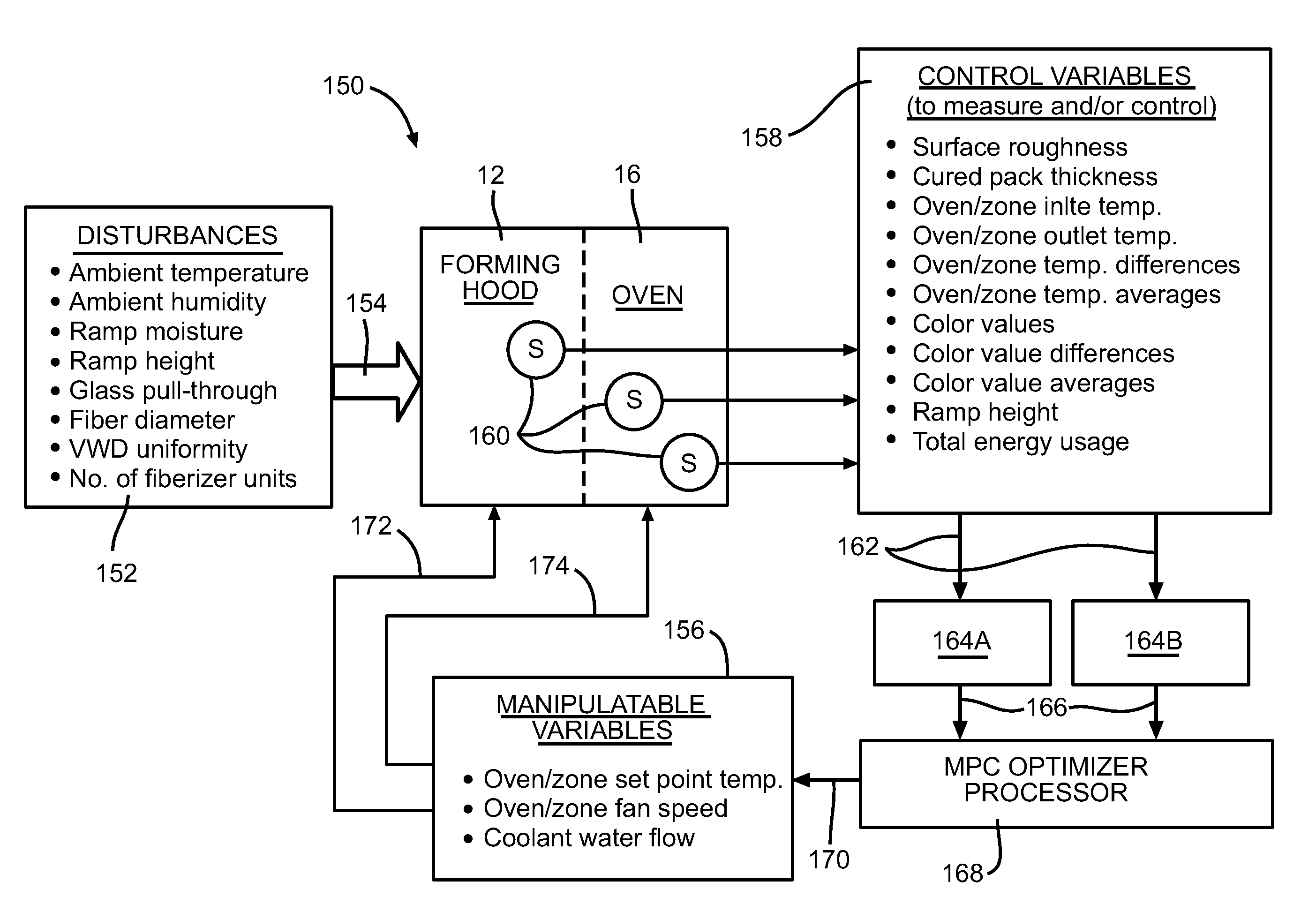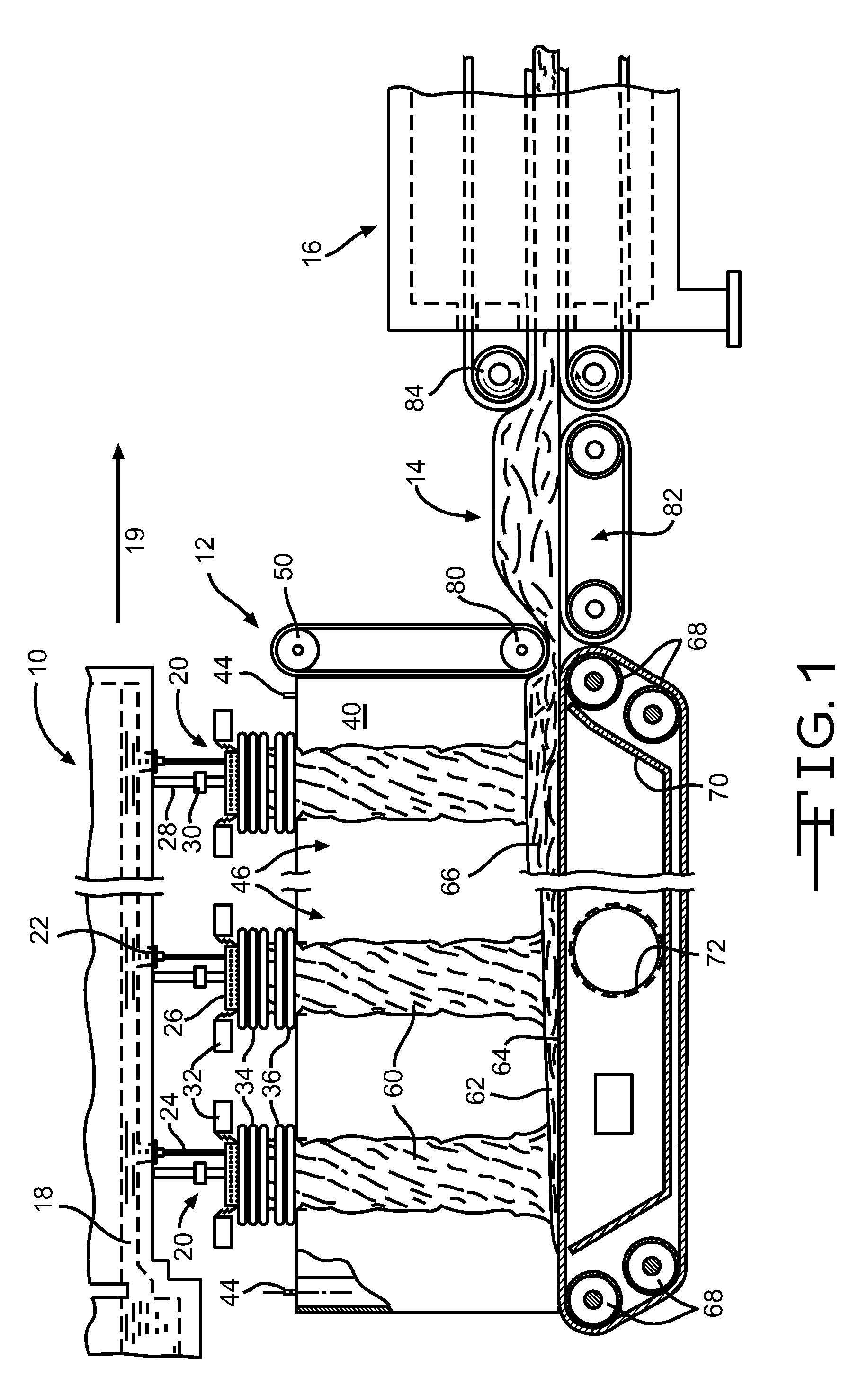Multivariable predictive control optimizer for glass fiber forming operation
- Summary
- Abstract
- Description
- Claims
- Application Information
AI Technical Summary
Benefits of technology
Problems solved by technology
Method used
Image
Examples
examples 1-3
Exemplary MPC Optimization
[0094]A MPC optimizer from AspenTech is programmed to monitor and control the variables shown in Table 1, below, in a four zone oven using the manipulated variables of: (1) fan speeds in zones 1-4, and (2) setpoint temperatures in zones 1-4. In each case, total energy use is selected for optimization, once selected variables are in control.
TABLE 1Selected Optimization SchemesExampleNo.Controlled variablesPrioritization to:11.Color B valueColor B value2.Average of multiple pack outlettemperatures at entry location of eachof zones 1-43.Average of multiple pack outlettemperatures at egress location ofeach of zones 1-421.Color B valueColor B value2.Average of multiple pack outlettemperatures at egress location ofeach of zones 1-431.Color B valueColor B value2.Average of pack outlet temperature ategress location of zones 1, 3 and 43.Difference between inlet and outlettemperatures at egress location ofzone 2 (i.e. Z2GI − Z2GO)41.Color B valueColor B value2.Averag...
examples 5-6
Exemplary MPC Optimization
[0095]A MPC optimizer from AspenTech is programmed to monitor and control the variables shown in Table 2, below, in a four zone oven using the manipulated variables of: (1) fan speeds in zones 1-4, (2) setpoint temperatures in zones 1-4; and (3) coolant water flow into the forming hood. In each case, total energy use is selected for optimization, once selected variables are in control except, in Example 5, Color B difference was selected as a secondary optimization variable in addition to total energy use.
TABLE 2Selected Optimization SchemesExampleNo.Controlled variablesPrioritization to:51.Ramp heightColor B difference2.Difference between inlet and outlettemperatures at egress location ofzone 2 (i.e. Z2GI − Z2GO)3.Average of multiple pack outlettemperatures at egress location ofeach of zones 2-44.Overall color B value5.Difference in color B valuesbetween top and bottom ROIs of asection61.Color B valueorder listed2.Ramp height3.Difference in color B valuesb...
example 7
Selected Corrective Actions
[0096]The following Action Tables set forth some corrective actions to take in given situations depending on the cure status of various sampled locations. Many of these can be automated using continuous, online measurements and a dynamic MPC processor.
Process Issue: Bright Pink Areas in Interior Batts (Under Cure)
[0097]
ActionEnsure proper weight distribution across all lanesLook for plugged areas on the Oven FlightsLook for sources of excess moisture on the Forming ChainLook for sources of excess moisture from the fiberizing areaEnsure that Oven fan speeds are optimized: run each fan as fast aspossible without blowing craters in the surface (updraft zones) ordegrading machine thickness (downdraft zones).
Process Issue: Interior Top Is Under Cured
[0098]
ActionCheck for plugged areas on top oven chainVerify Ramp Height is at targetIncrease temperature in last two oven zones by 5° each (react zone) or10° each (reject zone)Increase fan speeds in last two oven zo...
PUM
| Property | Measurement | Unit |
|---|---|---|
| Angle | aaaaa | aaaaa |
| Angle | aaaaa | aaaaa |
| Angle | aaaaa | aaaaa |
Abstract
Description
Claims
Application Information
 Login to View More
Login to View More - R&D
- Intellectual Property
- Life Sciences
- Materials
- Tech Scout
- Unparalleled Data Quality
- Higher Quality Content
- 60% Fewer Hallucinations
Browse by: Latest US Patents, China's latest patents, Technical Efficacy Thesaurus, Application Domain, Technology Topic, Popular Technical Reports.
© 2025 PatSnap. All rights reserved.Legal|Privacy policy|Modern Slavery Act Transparency Statement|Sitemap|About US| Contact US: help@patsnap.com



